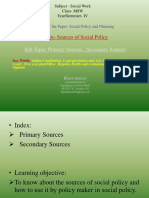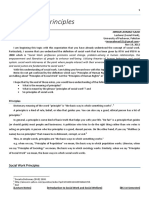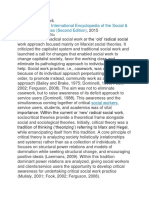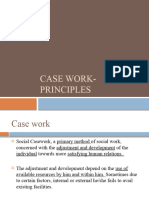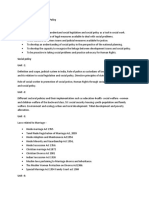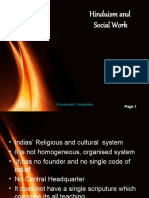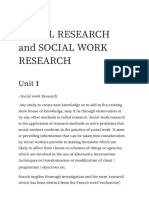0 ratings0% found this document useful (0 votes)
970 views17 pagesModels of Community Work
Uploaded by
Shahnawaz ahmadCopyright
© © All Rights Reserved
We take content rights seriously. If you suspect this is your content, claim it here.
Available Formats
Download as PDF or read online on Scribd
0 ratings0% found this document useful (0 votes)
970 views17 pagesModels of Community Work
Uploaded by
Shahnawaz ahmadCopyright
© © All Rights Reserved
We take content rights seriously. If you suspect this is your content, claim it here.
Available Formats
Download as PDF or read online on Scribd
You are on page 1/ 17
CHAPTER IV
MODELS OF COMMUNITY WORK
‘The history of social work education and practice is, in part, a history of
massive ideological distortion. Conceptualizations about social work are primarily
social products and reflect the particular socio-economic base upon which social-
welfare institutions have grown. It is not necessary to see this process of
ideological distortion and mystification in terms of conspiracy. Rather it should
be seen as the outcome ofa deep contradiction within social work systems under
capitalism, which enhance human welfare and negate it within the same process
(Leonard,1975).
Confusion and contradiction are characteristic of most practical situations
in social work. Social workers have seldom felt the need to work out a framework
jn which to make their value assumptions explicit, and to deliberate their goals and
the process of achieving them in tune with these value assumptions. Nowhere has
the confusion been greater than in community work practice. The term
“community organization” connotes different meanings for professionals. It
{s,therefore, necessary to attempt a broad classification of different approaches
tothe practice of community work, A reference has been made tothe three different
approaches identified by Ross: the specific content approach, the general content
approach and the process approach. To this can be added the three models of
community organisation suggested by Rothman (1979), ie locality development,
social planning and social action. The locality development model refers to the
popularnotion of community organisation practice, whereby a worker or an agency
attempts to develop various services or programmes to meet the needs of a target
population in a defined area. This may also include the coordination of ‘various
agencies providing services in the area and the generation of new programmes
and services as well.
‘The social planning model refers to community work where a worker or an
agency undertakes an exercise evaluating the welfare needs and existing services
ina town, village or municipal area, or maybe in a State, and suggest a possible
blueprint for more efficient delivery of social services. Generally such attempts are
confined to particular fields, such as housing, education, health, child care or
women’s development. Some may include plans for a better transport system or
drainage facility under this type of community work.
Working with Communities
“The social action model refers to community work which is issue-oriented
and attempts to generate a social movement. The worker or agency attempts to
mobilize public opinion on a particular issue by educating people. The issues may
range from organizing relief during a natural calamity, or combating problems like
‘dowry or wife battering toamore radical change in society or in a social institution.
‘A comparative statement ofthe three models outlined by Rothman (1979)
in terms of the goals, assumptions, strategies, etc, is given below:
MODELS OF COMMUNITY WORK PRACTICE
Dimension of | Locality Social Planning Social Action
‘Comparison | Development
Goals: SelfHelpand _|Problem-solving | Shifting
‘Community of substantive powerand and
integration [community problems | resources
‘Assumptions | Community lacks | Substanti Disadvantaged
viablerelation- _ |social problems populations
ships and exist, eg. experience
democratic | poverty, social
problem- lunemployment, injustice,
solving illiteracy. inequality and
capacity. deprivation
Basic Change | BroadCross- | Fact-gathering
strategy section and rational issue and
‘ofcommunity [decision-making _| organize
indetermining _Jonmosteffective __| people to
and solving {course ofaction. _| take action
problems against
enemy targets.
Improve Build consensus or | Induce conflict
‘community induce conflict. through confron-
relations among, tation, direct
different groups. action and
Build consensus. negotiation
‘Agency types} Settlement house; Welfare councils; | Social
Peace Corps; [planning bodies.
consumer
associations
‘Source: Rothman (1979)
Models of community work n
Ross and Rothman have attempted a classification of community work
practice on the basis of goals. Blum and Meyer suggest that a classification
‘of community work practice can be made on the basis of means or strategy
‘employed to achieve these goals, such as concurrence, negotiation or contest.
‘As Chatterjee (1975) pointed out, while goals and means/strategies are
important determinants of community organisation efforts, several other
factors must also be taken into account. Zald (1966) has suggested that the
constitution of an organisation emerges and is partly maintained to satisfy a
given constituency. Though it may give a mandate to the organisation, the
‘characteristics of the constituency may place limits on goals and means.
‘Chatterjee indicates that these formulations suggest that there are two
essential dimensions to community organisation: (a) goals and means; and (b)
the nature of the constituency. Chatterjee thus developed a theoretical paradigm
‘based on these two dimensions of community work, He used. Marshal's n
of civil rights and social rights to elaborate the concept of goals and means.
He explained the nature of the constituency with Merton's concepts of ‘cultural
goals’ and ‘institutionalized means’; together with Komhauser's concepts of
‘availability of masses’ and accessibility of elites and subsequent formulations
of these concepts. The early model of community work - i.e. reconstruction of
the small community - failed to differentiate between civil rights and social rights.
Civil rights may be theoretically defined as rights to certain behaviour patterns,
whereas social rights are rights to various tangible goods and services.
Marshal was clearly implying that the political and economic systems of a
capitalist society may promise civil rights to all citizens. However, the promise
of civil rights does not guarantee delineation of social rights, though it may
facilitate a move in that direction.
It is no mere coincidence that community development as a mass
programme in India did not emerge ‘until the middle of this century, when
some form of civil rights were guaranteed to all. Similarly, the reasons for
the lack of enthusiasm on the part of the masses are not far to seek, as
the mere guaranteeing of civil rights in the absence of any delineation of
social rights were meaningless for them. The absence of economic stake
negates or dilutes, the sense of belonging to the community. However, the
guarantee of the civil rights did initiate certain changes which led to some
rethinking about social rights. The right to collective bargaining led to a
‘questioning of the existing sharing of goods, services and power in society,
with some tangible results in the form of better wages and working
conditions, land reforms etc, Community work takes a different form, in
initiating a process of awareness, to make use of the existing civil rights
to demand better social rights.
n Working with Communities
Chatterjee provides the worker a valid theoretical framework, to analyze
his/her approach as well as the response of the community. But in the final
analysis, the goals and the means adopted to achieve them remain the main
basis for the identification of different types of community work. However, the
distinction between different approaches becomes more clear, if one is able to
define the word “community” and analyze the goal in terms of the attempt to
promote civil rights or social rights. In India, the tradition of evaluating the
intervention, of social work has been rather weak. Researchers have struggled
to develop appropriate methodologies for action research. Action research
based on social theory is yet to emerge . The framework developed by
Chatterjee may help researchers to develop more appropriate research designs
in the field of community work research.
It may be worthwhile to give a more concrete shape to the ideal types of
‘community’ the worker may have in mind. Ideal types are the visions of what
a community should be. They may be visions which are trying to reconstruct
bygone eras or dreams to evolve new social institutions that will reflect a
particular set of social values. We shall therefore examine some past efforts to
recreate some ideal types of community, and the success or failure of these
efforts, It will help in talking more concretely about various types or models of
community work later.
‘Owenite Socialist Community - “New Harmony”
“New Harmony” was one of the seven Owenite socialist experiments in
community organizations in the United States in the 19th century. It lasted
for two years. Owen, the founder, believed that to change men it was necessary
to change the physical and social environment in which they live and work.
‘The new environment he had in mind was a “small community’ with the
‘communal ownership of property. Eight hundred people voluntarily came
together to live in one particular area. The community was govemed by an
elected committee. During the early phase, there was hardly any productive
activity, and people were generally dependent upon Owen's money. Later, the
community was reorganized into a system of three independent communities:
the school or educational society, agricultural society and mechanical society.
‘A board was expected to regulate interaction between the three societies. The
system did not work, due to mutual conflicts. Many revised versions of
relationships within the community did not work, and the experiment was
finally given up after two years (Thorns, 1976).
‘Among some of the reasons listed for its failure were a lack of organi-
sation and a failure to arrive at an agreed structure, and ideological controversies
among its members, due to unrestricted entry into the community. Conflicts
between various elements forced some even to leave the commu
‘Models of community work B
KIBBUTZIM
‘The kibbutz were founded with a belief in co-operative living, which mean
that all property was owned collectively, all work has collectively organized,
‘and members ate and lived collectively. The values underlining the kibbutz
are: the importance of productive labour, self-sufficiency, all jobs being done
by the members themselves, all property belonging to the entire community
‘and complete equality within the community. The principal economic activity
‘was agriculture, but some industrial activity has been introduced in recent
‘years, There are three main units, each concerned with one activity that is eco
‘nomic, social, ideological and educational. The general body consisting of all
males and females who are full members. Itis the main decision making body.
‘The Kibbutz encountered a series of problems over the years, which pro-
vide good insights into the ability of community organizations to accommo-
date or withstand pressures. The first problem related to consumption, as kib-
butz has provided little scope for individual taste or choice in matters of cloth-
ing, food and personal possessions. The second area of conflict was inter-
personal behaviour. The family and small group became more popular for per-
sonal interaction, and it inevitably came into conflict with _communing rela-
tionships. This happened partly as a result of the status of women, Women
“Were generally assigned unproductive roles, such as cooking, cleaning and
working in the kindergarten. Women were thus dissatisfied with their position.
‘They wanted greater control over their children, and to have greater domestic
comfort. Many young persons left the kibbutz despite being brought up in a
community environment. This shows that a sizeable proportion rejected the
values of the community (Thoms, 1976). The kibbutzin were unable to provide
any motivation to their members to accept more responsibility, and the self-
sufficiency theory also failed, since they had to hire labourers, giving rise to a
class of wage-earners within the kibbutz community.
‘COMMUNES
Communes in China were founded on similar premises, where the land.
‘was commonly owned and every one was expected to eat out of a single big
iron pot. Each member was to be given his/her due, irrespective of what he
contributed to the production of goods and services. It was part of an effort
to build a society in which every member could share in the future abundance,
and in which everyone had an equal opportunity to contribute to that
prosperity. Advanced agricultural producers’ co-operatives were established
and their principles and broad administrative procedures were worked out. In
‘essence, rural cooperatives were able to provide cash and support in kind to
the aged, the weak, orphans, the widowed and the totally disabled, who
lacked any independent means of support. This assistance was financed by
"“ Working with Communities
the co-operative welfare fund, into which no more than two percent of the co-
operative’s income could be directed. These co-operatives were later changed
into rural communes. The communes provided modest income support to the
sick and injured and to poor families. The five-guarantees system in China
was intended to provide peasants with a guaranteed minimum supply of food,
clothing, medical care, housing, and burial expenses (Dixon, 1982a).
In urban areas, China adopted an area-oriented, community-based ap-
Proach to the provision of social services, in which local resources were used
to cater to local community welfare (Dixon, 1981b). Specialist organizations
were set up involving community volunteers - notably housewives and the
elderly - to provide a wide range of welfare facilities, such as workshops for
the elderly, handicapped and unemployed, nurseries and day care centres,
counselling services, information dispensing, dispute arbitration and home
help services for the sick, elderly and the handicapped (See Bacon, 1975; Sidel,
1974; Wang, 1976).
This approach has helped China to ensure a better availability of social
services to different communities both rural and urban. However, it has been
suggested that communal ownership of economic resources created problems
‘of motivation to work, and that as a result production either declined or
stagnated. This led to the recent changes in China, whereby some
‘modifications to the rule ot communal ownership has been effected, to allow
more enterprising families to produce more. This will inevitably mean that
esponsibility will be shifted for meeting welfare, social security and other
developmental services from the community to the family. The inability of
human beings to work for non-monetary reward is obvious.
‘These examples have been quoted, simply to help workers give a more
tangible shape to the ideal types of community, or the arrangement of human
relationships in society in general. These examples also serve the purpose of
raising a number of questions.
The assumption of a natural human tendency to co-operate with others
to meet needs that can be only met collectively, needs re-examination,
particularly when no viable individual gains from the effort can be specifically
demonstrated. Collective welfare is a low priority area for all, even in closely-
knit religious and culturally homogeneous communities.
The identity of a community may decline subsequently, rather than
increase, as conditions change around the community. Family ties continue
to be the central focus of human activity and generally play a decisive role.
‘The reconciliation of individual and family interests with the collective interest
is more a function of necessity than a matter of choice.
Models of community work
Both kibbutzim and communes however confirm the macro-micro link in
determining the nature of the micro. Community-level efforts can thus restruc-
ture relationships only up to a certain point. Similarly, they can change the
socio-economic resource level of the community only marginally.
‘The scope of community work during the 1970’s in Britain covered a
variety of activities. It took note of the fact that when a worker faced depri-
vation or social problems, this called for the payment of some attention to the
larger social and political dimensions of this micro-reality. There came a re~
alization that all is not well with our society, with its tendency towards tech-
nological and materialistic goals, and towards a subordination of the
individual by what is often called “the system”. On the other hand, there is
a desire on the part of the common man to assert his right to participate in
the decisions that affect him and his way of living. This suggests the use of
a wide framework to guide a worker as she approaches her task in community
‘work. But this could create confusion for her unless some categorization, even
if it is not a very neat ideological formulation, is available to guide one in
practice (Siddiqui, 1989). This would facilitate a conscious choice on the part
of the worker on the type of focus she wants to maintain in practice.
Consequently, three models of practice similar to the one suggested by
Rothman, are outlined below:
1. Neighbourhood development model
2. System change model
3. Structural change model,
1. Neighborhood Development Model
This is perhaps the oldest form of community work, where the general
assumption is that people living in a community (read neighbourhood) have the
capacity to meet a number of problems through their own initiative and
resources. The worker is expected to induce a process which will make the
community realize this and consequently make efforts to achieve a greater
degree of satisfaction for the of al its members, individually and collectively.
Recent changes in this model of community work lay more emphasis on the
development of a self-sustaining indigenous organisation within the
community to take over this role from the workers or the agency as soon as
possible, Thus, the role of the worker is seen as unleashing developmental
‘energies within the community, rather than acting as a provider of services. The
value emphasized is self-sustenance, rather than dependence on outside help.
‘The worker in a neighbourhood development model can deal with a
variety of issues which may range from developing better relationships within
different sections such as caste groups, linguistic groups or religious sects,
6 Working with Communities
to changing people’ attitudes about women, a small family norm, and
raking use of available social services. Contrary to the general understanding
ton the part of workers to generate services to cater to peoples’s needs or
Smprove the physical surroundings of the community “by introducing the
Concept of drainage or proper roads, the neighbourhood development mode)
an be employed to develop new ideas. The emphasis here is to encourage
thinking on the part of people themselves, rather than to do things for them.
‘The neighbourhood development model has often been criticized for making
people more dependent on outside help. The fault lies with the mannet in
eench a worker or an agency uses the model, and not with the model itself
However, the limitations of effecting a change with little or no control over
tigore realities have already been pointed out. Still, the neighbourhood
evelopment model will, in all probability, continue to be practiced in India
and other third world countries.
“The experience of community work in India has provided usefil insights
into the likely success or failure of different models. One ofthe insights gained
is the difficulty of generating local resources, either for a specific programme
br for total development of the community. Hence, an over-emphasis on
fndigenous esources can lead to frustration. On the other hand, in the changing
cromomie scenario, State funding for community development project is likely
Teelteline. The main source of community work funding will continue to be
on-governmental organizations. A complete withdrawal of workers, even
the best planned neighbourhood model of community work, is not possible.
‘The neighbourhood development model should therefore plan for a long-term
involvement of the social worker or agency. The fact that change, and peoples’
participation in bringing about change, or its acceptance in Indian conditions,
fs 2 gradual process, lends additional weight to the need for a long; ter
perspective ofthis model. Further, it will not be possible for any community Wo
fully take over and run the development programme without any profession)
help. Hence, some form of supervision of a programme on a ongsterm basis
weave to be made, even in this model. Therefore although the social worker
Sr agency may plan for a partial withdrawal, which means employing more loa}
Ctswarces for day-to-day management, nevertheless they have to continue
professional supervision of the programme.
Models of community work
Figure. 1.
NEIGHBOURHOOD DEVELOPMENT MODEL,
‘SPECIFIC CONTENT APPROACH
‘WORKER
YOUTH GROUP
COMMUNITY ‘Economic
PARTICIPATION Programme
Problem/Programme : When the emphasis is on service Orientation/delivery.
Process Orientation : When the emphasis is on developing a Community
‘Nucleus to cater to community need/s.
Process Orientation
WORKER,
Programmes COMMUNITY
NUCLEUS
‘AGENCY
Working with Communities
The specific steps in the model are:
Identification, location and demarcation of the physical area.
Entry into the community
Identifying the needs of different sections
Programme Planning
Resource Planning
Developing an organisational network in the community
7. Partial withdrawal within a time frame.
‘SYSTEM CHANGE MODEL:
This model of community work has not yet become very popular, but
there is ample evidence to suggest that itis beginning to get more acceptance
in such diverse areas as environmental issues, women and health-related is-
sues. In this approach, various arrangements in society to cater to basic needs,
such as education, health, housing, employment, women’s empowerment and
environmental protection are considered as independent systems which also
hhave sub-systems. The ultimate rationale for their existence is both social pro-
duction and social consumption. The basic assumption in this model is that
systems can become dysfunctional due to a variety of factors, such as pop
lation growth. This means that the demand for consumption may increase. Simi=
larly, a change in values may signify that the quality of a product needs to be
changed, or a change in technology may signify a change in the methodology
of production. The cumulative impact of these factors may generate a host of
strains and pressures on any system. The system may become dysfunctional
either because what it is producing is not relevant for people, or because not
‘many people have access to what is being produced. At times it may produce
various categories of product for different sections of the population. This
leads to the unleashing of tendencies to maintain the status-quo in terms of
disparities between different socio-economic and/or spatial segments of the
population, rather than serving as an empowering mechanism.
The example of the education system in India and in other developing
‘countries will help make these formulations clear. The national policy docu-
‘ment on education in India noted that the general objects incorporated in the
earlier 1968 policy “did not get translated into a detailed strategy of implemen
tation, accompanied by the assignment of specific responsibilitc
cial and organisational support. As a result, problems of access, quality, quan-
tity, utility and financial outlay, accumulated over the years, have assumed
such massive proportions that they must be tackled with the utmost urgency”
(Government of India, 1986). It further pointed out that education in India
Models of community work -
Figure. 2
‘SYSTEM CHANGE MODEL
+ Data Collection Strategies
‘Awareness
Organisation
Action
Improving Education / Health / Water Supply
Process : The work begins in a community or in a number of communities,
which later spreads in different cities, states and finally in the whole society.
LEVEL ‘SYSTEM ISSUE (S)
OR
SUB SYSTEM
‘SCHOOL
0 Working with Communities
stands at the crossroads today. Neither normal linear development nor the
existing pace and nature of improvement can meet the needs of the situation.
The policy document asserted that the national education system will play a
Positive interventionist role in the empowerment of women and scheduled
castes and tribes. Subsequent data indicate that the system failed to achieve
these objectives.
It is common knowledge that social services in urban areas are far supe-
rior to those in rural areas, both in quality and quantity. Similarly, the kind of
education or health services one can buy in the market are far superior to State-
sponsored services. The quality of the product is one of the basic means of
‘maintaining the status quo in society. Thus, all our systems of delivery of de-
‘velopmental/social services for the people are suffering from various deficien.
cies and are unable to achieve their objectives. Symptoms of this dysfunction
are observed by the community worker in the community. S\he comes across a
School which not only lacks basic resources in terms of adequate space, class
rooms, furniture, playgrounds and library facilities, but also does not even have
Properly trained and efficient staff. The drop-out rate is phenomenal. Those
‘who manage to stay are still unable to make it to higher education. ‘They find
‘themselves far inferior in comparison to the products of elite/private schools,
The social worker would like to reduce the drop-out rate, and would also
like to improve the quality of the education being imparted. The resource level
of the school, as pointed out earlier, can only be marginally improved through
‘community efforts. Further, the worker or the community can do very little to
bridge the qualitative gap between the two different kinds of education, It is at
this point that the implications of the system of education and the impact of
other systems, such as political, and economic, on it, becomes obvious. Simi-
larly, itis necessary to understand the sub-systems of education, school, the
department of education and teacher's training institutes, and their function.
ing and impact on the whole system, in order to arrive at a useful framework
for understanding what one finds at the grass-roots level.
‘When this realization dawns on the worker, he/she may decide to collect
‘more facts and to develop a strategy of either restructuring or modifying the
system. This is termed as a “system-change” approach to community work.
Some of the specific tasks identified with this model are:
1. Collecting relevant facts about the specific deficiencies in the system,
£8. urban bias, disparity in access to services, lack of trained
functionaries, inadequate delivery structure, and lack of funding, leading
to inadequacy of material, equipment and space,
2 Sharing the findings with the community/communities.
Models of community work 8
3 Selecting an appropriate strategy to influence decision-making bodies
or to focus attention on the issue,
Mobilizing community and outside support to put the plan into action,
5. Developing an organisation in the community and linking it to. similar
organizations in other communities, and other voluntary organizations,
which can help them in demanding change,
3, STRUCTURAL CHANGE MODEL
The “structural-change” model of community work is viewed as a small
cell within the larger body of society. In other words, various tiny communities
constitute the bigger whole i.e., a society or @ nation-state. The major
assumption in this model is that the manner in which the relationship between
different sections of the population is structured, formally (constitutional
frame work, law, state policies ete.) or informally (customs, public opinion),
largely determines the social rights of individuals. This consequently
determines the relationship of the State vis-a-vis the individual or a community
and intra- community and inter community relations. For example, the way
relationships in a society, are structured, provides for maximum autonomy and
freedom to the individual. In such circumstances the’community’ also does
not have any obligation towards its individual members in terms of need-
fulfillment. If all members agree to pool their resources to meet some of the
problems and needs which they think can be met more adequately through a
collective effort, they may do so.
The social structure in some societies is such that the State regulates
individuals to control the production and consumption of economic resources,
in order to ensure a certain level of need-fulfillment for all, or for the more
needy section of society. In the structural-change model, therefore, the worker
analyses the link between the macro structuring of social relationships and
the micro-reality of an unemployed youth, or the general lack of access of people
to education or health facilities in the community, etc. The worker tries to
mobilize public opinion to radically alter the macro -structure.
‘This isa far more complex task for a community worker. It calls for very
different kinds of skills from those that an ordinary community worker generally
possesses. It requires, above all, an understanding of human society in al its
myriad dimensions: economic, political, social and cultural. Most community
‘workers will not be able to explain the relationship between current wage rates
and the type of economy, or the concept of State and social development, not
to mention the process of formation and legitimization of the State. Therefore,
though a worker may have a vague notion about the possibility of a link between
micro-and macro-realities, he is unable to give it a definite shape. He looks at
2 Working with Communities
1 fragment of the total social reality, which needs change. He pursues a system-
‘change model rather than a structural-change model. A structural change model,
hhas to work out an altemative form of society, which will transform existing
micro level of community. It means the adoption of an
ted by factors or powers outside the
nation-State. For example, in the case of many third-world countries, the
influence wielded by the International Monetary Fund, World Bank and big
Powers is a well-known phenomenon. These organizations sometimes make it
‘extremely difficult for a nation-State to take decisions in respect of various
issues which vitally affect the distribution of goods and resources in society.
At times, therefore, there is a need to influence the larger world order, to be
able to effect changes in either a nation State or a whole group of nations
saiffering from the international policies.
‘The complex nature of the structural-change model, a lack of preparedness
on the part of the worker, a feeling of lack of faith or relevance jin the com-
‘munity, and the conflict such a model is likely to generate, make this by far the
‘most difficult and rarely practiced mode! of community work. The specific tasks
involved in the model are:
To develop an understanding of the link between micro-and-macro social
realities.
To make a conscious decision about an alternative political ideology.
To share this understanding with the community, to enable it to make its
‘own decisions.
To help the community identify a plan of action to pursue its goal by
locating specific issues and consequent action to launch a long struggle.
To help the community sustain its interest, enthusiasm and capacity to
meet the strain which is likely to arise out of an inevitable conflict with
the existing power structure
The structural-change model of community work may thus originate within
4 community. But its scope later widens to encompass an entire society or
nation-state. Though it may start as community work, it translates itself into
another method of social work: social action. This may be another reason why
community workers traditionally considered it outside the scope of their work.
‘A form of community work which was termed ‘radical’, was essentially
viewed as an educational process, sharing general aims with other forms of
‘education. This type of community work describes ways of helping people to
understand the complexities of modern society, and the kinds of individual and
Models of community work 8
collective action which are available to common people. Naturally, the
achievement of any goal, including the attainment of any viable change, is not
the real objective, What is important is that people gain in terms of greater
self-confidence, organisational and social skills and an understanding of vital
issues which concer them in society (Baldock, 1974). This may help the worker
to realize that in the structural-change model he may not succeed in achieving
any goal. But what he accomplishes nevertheless,is that he sows the seeds
for social change to take place later, even though it may take years or decades
It is also essential for a worker to keep in mind that his or her own un-
derstanding, and that of the community, is likely to undergo substantial change
in the course of time. Many workers who may previously have believed in the
Bolshevik traditions of socialism, may find democratic socialism more functional
now, particularly since the collapse of the Soviet block. Similarly, a social worker's
understanding or his change options may not be acceptable to the community,
or the community may fail to arrive at a consensus on the issue. In all such
situations, the worker is in a rather difficult position. He has the option to
withdraw or to continue to support the community, despite these differences.
In Indian or Third-world contexts, the general condition of the masses makes it
difficult for the community worker to practice the structural-change model, since
there.is a strong tendency among common people to remain passive observers,
Similarly, differences are fairly common among social workers operating
within a community over values, and the consequent prescriptions or strategies
for change. In such instances, the personal influence or qualities of workers
may act as a vital force. More dominant workers may prevail over their
colleagues, or others with equal influence or commitment may decide to leave
the project. A recent study, however, indicates that most workers have no
commitment to any particular ideology, and lack clarity about any ideological
frame work. This may be one reason why discrepancies can be found in the
ideological orientation of organizations working in the community, and their
programmes and practices (Alphonse, 1991). Yet, this may be what helps them
to continue to work together, despite a lack of consensus, The community-
work group identified three levels of community work:
1. The Grass-roots or neighbourhood level, which basically refers to the
‘community-development approach.
2. Local agency and inter-agency level community work aimed at establishing
and sustaining a secondary group, such as a youth or a women’s
‘organization to co-ordinate local groups with a regional or national
organisation, or co-ordinate different agencies with common interests to
meet a specific need such as women’s education or child care.
Working with Communities
Regional or national level community work, which is more planning-
oriented rather than focused on finding a solution to any specific issue,
‘This type of community work is research-oriented, and many may not even
consider it as community work practice.It may be termed as an exercise in
social planning, or the formulation of social policies.
However, the thinking on models does help to identify a type of
‘community work which does not belong to the three models mentioned above.
The scope of this type of community work is wider than the neighbourhood
model, where the primary concern seems to be to locate new services or to
modify or improve existing ones within a ‘community. Here the worker attempts
to help the community think of ways in which it can meet a need by
collaborating with other communities who may have similar problems or needs.
‘This may be termed as the inter-community model of community work.
‘The Inter-Community Model of Community Work
“There are certain problems or needs which cannot be tackled, either
the community or through community resources-for example, unemployment
or training facilities to upgrade skills and improve income levels. Even
recreational facilities, specialized training, education or health facilities cannot
be adequately provided within the community. Low-income levels in most
communities which need social-work intervention make it difficult to initiate
and sustain a programme which aims at meeting needs such as these within a
section of the community. The response of people to participate in a programme
designed to upgrade their skills and make them self-reliant, or improve their
economic condition in the Indian context, is generally poor. They are unable to
contribute anything towards the programme. This ells for an inter-community
approach. The worker locates the programme in a place where people from
different communities can come and participate. In this case, the worker visits
various communities, to make people aware of the programme and motivate
them to participate. A community nucleus, in the form of people who have
already participated in the programme, or other influential people, can be
established, to dispense information and enroll names of participants. Another
example of an inter-community model i to establish a health or education centre
through the combined effort of different communities. In this case,
representatives of different communities participate in deciding the programme,
its location and the mode of sharing resources or responsibilities for its
‘management. This model of community work can lead to the establishment of
‘an organisation or council to provide specific services in different communities.
‘The inter-community work model is different from the neighbourhood
model, since the scope of its coverage is wider than the neighbourhood
which is conceived as a community, It differs from the other two models,
since the goal is to meet local needs, rather than attempt a change in the
Models of community work 8s
system or structure. The inter-community model can prove extremely effective
in making available specific services. The experience of various
neighbourhood models has indicated that when they address a specific need
in a neighborhood, e.g. training adolescent girls or boys for self-employment,
they encounter many problems. Initially, attendance is very low, and
subsequently, there may not be enough people who need the training.
‘Therefore, except for a brief period when the facility is utilized fully, generally,
the facility remains under-utilized. Because of these reasons it is difficult to
convert such facilities into a self-sustaining activity. The inter-community
model offers a way out of these problems.
In the inter-community model, a worker begins by identifying specific
need areas within a wider geographical locale than could possibly be described
‘as a neighbourhood, Subsequently, he/she would explore the possibility of
‘encouraging people from different communities to participate. He/she may
have to make transport arrangements, besides generating enough motivation
among people to travel the distances instead. Such a programme could be
more successful with young people, though even children can easily be
encouraged to participate, particularly if adequate transport facilities are
arranged. A number of issues can be tackled by the inter-community model,
ranging from the organization of recreational and cultural activities, to the
improvement of relations between different communities.
‘Multi Community Development
In the parlance of Douglas (1989), multi community development is a
mass enhancing strategy. By working with their neighbors -largely untapped
resources - small towns can increase their store of resources and raise their
effectiveness beyond that of towns acting alone. As territory expands, so too
does potential economic and political power to influence social policies or to
pursue collective interests.
‘The approach is innovative because small towns cooperate rather than
compete with each other. Structural adjustments may be made while correcting
some of the major shortcomings of externally imposed structural solutions.
‘Because participation is voluntary, regional efficiencies may be achieved whi
‘maintaining a degree of local autonomy. By shifting from single to multi-
‘community development, small towns can stem economic decline and lay the
groundwork for more sustainable development.
‘A number of examples of small towns banding together in multi-
community clusters are found in Towa. The first voluntary multi-community
cluster in Iowa was formed in 1986. The Area Community Commonwealth is
a “35-square mile neighbourhood” in north central Iowa. The seven member
‘communities range in size between 180 and 1,200 people. The average
istance between communities is 13 miles (Betty L. Wells, 1991).
You might also like
- CC1 History & Philosophy of Social WorkNo ratings yetCC1 History & Philosophy of Social Work21 pages
- Social-Welfare-Administration, Ngo Structure +No ratings yetSocial-Welfare-Administration, Ngo Structure +47 pages
- Unit II Society, Human Behavior and CommunitiesNo ratings yetUnit II Society, Human Behavior and Communities94 pages
- MSW Social Work MCQ Pass CUETPG21@MCQ24No ratings yetMSW Social Work MCQ Pass CUETPG21@MCQ24470 pages
- PG - M.S.W. - Social Work - 349 22 - Community Organization and Social Action - MSWNo ratings yetPG - M.S.W. - Social Work - 349 22 - Community Organization and Social Action - MSW286 pages
- Unit VII - Social Policy, Planning and Social Development.No ratings yetUnit VII - Social Policy, Planning and Social Development.95 pages
- A Model of Code of Ethics For Indian Social100% (1)A Model of Code of Ethics For Indian Social6 pages
- Distinction Between Social Research and Social Work Research100% (1)Distinction Between Social Research and Social Work Research1 page
- MSW Course Content New Syllabus M G University67% (3)MSW Course Content New Syllabus M G University34 pages
- VSSS Annual Report 2010 2011 For WebsiteNo ratings yetVSSS Annual Report 2010 2011 For Website56 pages
- Social Action and Social Movements Previous Year QuestionsNo ratings yetSocial Action and Social Movements Previous Year Questions3 pages
- Group Work Definitions (H.B.Trecker - 1955)No ratings yetGroup Work Definitions (H.B.Trecker - 1955)5 pages
- Social Legislation: Definition & ImpactNo ratings yetSocial Legislation: Definition & Impact10 pages
- Unit VI Unit VI-Administration, Welfare and Development ServicesNo ratings yetUnit VI Unit VI-Administration, Welfare and Development Services33 pages
- Hinduism and Social Work: Powerpoint Templates Powerpoint TemplatesNo ratings yetHinduism and Social Work: Powerpoint Templates Powerpoint Templates23 pages
- Definition and Basic Characteristics of Social ChangeNo ratings yetDefinition and Basic Characteristics of Social Change3 pages






